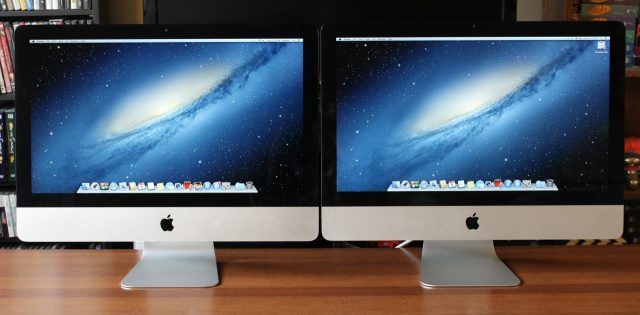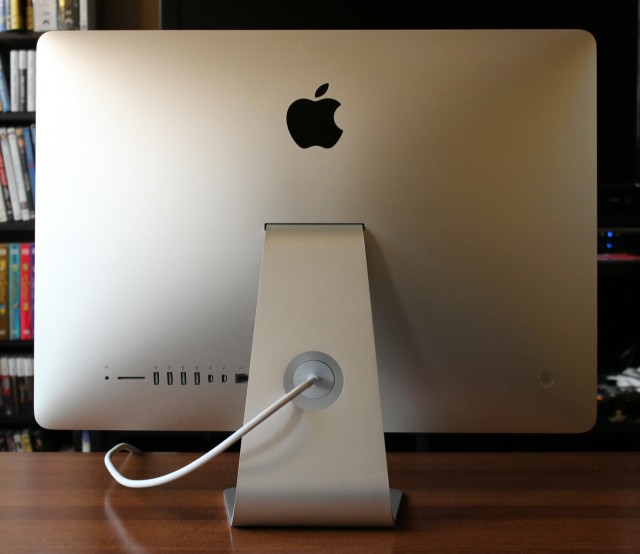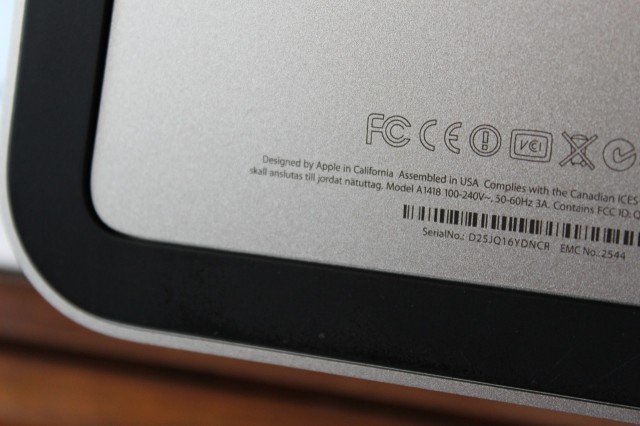
| Specs at a glance: 21.5-inch 2012 iMac | |
|---|---|
| Screen | 1920x1080 21.5" IPS display (102 ppi) |
| OS | Mac OS X 10.8.2 |
| CPU | 2.7GHz Intel Core i5-3330s (Turbo Boost 3.1GHz) |
| RAM | 8GB 1600MHz DDR3 (upgradeable, but not user-accessible) |
| GPU | Nvidia Geforce GT 640M with 512MB of GDDR5 |
| Storage | 1TB 5400RPM hard drive |
| Networking | Dual-band 802.11n, Bluetooth 4.0, gigabit Ethernet |
| Ports | 4x USB 3.0, 2x Thunderbolt, headphone jack, SD card slot |
| Size | 17.7 x 20.8 x 6.9 inches (45.0 x 52.8 x 17.5 cm) |
| Weight | 12.5 lbs (5.68 kg) |
| Starting price | $1299 |
| Other perks | 720p FaceTime HD camera, dual noise-canceling mics, ambient light sensor, Kensington lock slot |
Apple isn't normally the first company to put new chips from Intel, AMD, and Nvidia in its products, but the wait for the new iMacs has been long by any standard. Some 19 months have passed between the early May introduction of the 2011 iMac and the late November shipping dates for this year's models. But the Intel CPUs and Nvidia GPUs the 21.5-inch model uses were both available months ago, and these desktops haven't made the jump to a pixel-quadrupled "Retina" display. No one knows for certain whether the device's delays were due to rumored manufacturing issues or merely the decreasing importance of desktop computers to Apple's bottom line, but at least the refreshed computers are finally here.
The 2012 iMac's most visible innovation is, of course, its physical design—this is the first substantial change to the iMac's body since the aluminum unibody iMacs were introduced in late 2009. The edges of the computer are just 5 mm wide, a significant reduction from the desktops the company has been selling for the last few years. The end result is a computer that is substantially lighter and thinner than it was before.
Happily, the newest iMacs still retain most of what made past models appealing—the graphics processors won't set any speed records, but they compare favorably to those in competing all-in-ones. Fast, desktop-class quad-core Ivy Bridge processors from Intel power every iMac within the pricing spectrum. The screens, while not of the Retina variety just yet, are excellent IPS panels with great color and viewing angles. There are several improvements subtly enhancing their quality over previous models. And as with other all-in-ones, cable clutter is kept to a minimum.
Despite that progress, there are a number of regressions—particularly in the $1,299 21.5-inch model we're looking at in this review. These new iMacs really are attractive machines, but what features are sacrificed in pursuit of thinness, and can you live without them?
Body and build quality

The new iMac is going to take up about the same amount of space on your desk as the old model—the thinner body of the machine doesn't subtract much from its "stand depth." That's still 6.9 inches (down from 7.42 inches on the old model). What's much more noticeable is the machine's weight: at 12.5 pounds, it's exactly eight pounds lighter than its predecessor. You can immediately feel it when you lift the computer and move it around.
Though its body is much thinner and lighter, the new iMac has a lot in common with the preceding aluminum unibody design (which was itself not drastically different from the first aluminum-and-glass iMac introduced back in 2007). The front of the system is mostly taken up by the 1920x1080 display, its surrounding black bezel, and the sheet of glass that covers both of them. The "chin" below the screen and the back of the computer are one solid piece of aluminum mounted on a separate stand. As with all of Apple's aluminum unibody hardware, the fit and finish is excellent. There's nothing about the new iMac that looks or feels cheap.


The monitor stand is very slightly smaller than previous models due to the computer's decreased weight. It will continue to be a sticking point for some—where the competition can often swivel, pivot, and go up and down, the iMac's stand still only allows for tilting the screen up and down. The high-quality IPS display panels that Apple uses ensures viewing angles are never a problem. But if you need to raise (or lower) your iMac significantly to make yourself more comfortable at your desk, you'll have to figure something else out.

While the new iMac is indeed very thin around the edges, Apple's product photos don't convey that the new iMac still packs much back. All that computer has to fit somewhere, and the iMac tucks most of it away in the juicy bubble on the back of the machine. It's still much thinner than the old model, make no mistake, but while buying the iMac at the Apple store I heard more than one fan gushing about how the whole system was LCD-thin throughout. That isn't quite true.

The thing about the new iMac is that once it's on your desk, you don't often notice how thin it is. Viewed from the front, it's basically indistinguishable from the last few models (as you can see in some of our comparison shots). This isn't a bad thing, really, and it's still a very attractive computer. But it goes to show that you can really only do so much from a design perspective with an all-in-one that is, by necessity, mostly screen.
reader comments
293